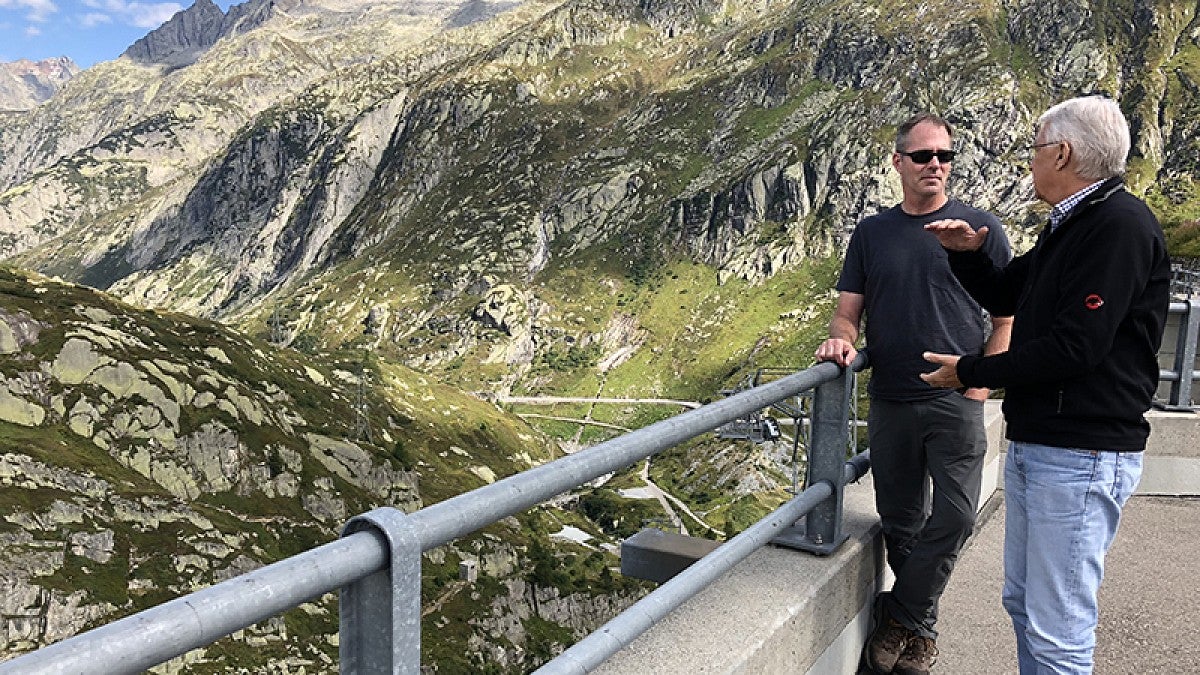Mark Carey never saw it coming, but his 20 years of research in a region of South America strongly affected by glaciers have elevated him into international mountaineering fame.
Carey, a historian in the UO’s Clark Honors College and director of the Environmental Studies Program, received the King Albert Mountain Award during ceremonies Sept. 8 in Pontresina, Switzerland. The honor goes to “persons or institutions that have distinguished themselves in some way in the mountain world.”

“I was pretty surprised. I was in shock when they got in touch with me,” Carey said. “I appreciate this award because it values the historical context that I bring into research on glaciers, climate change and natural hazards. And it recognizes the fundamental importance of cross-disciplinary collaborations, which I have increasingly put at the forefront of my research practices with concepts like hydro-social modeling and integrated disaster prevention.”
The awards, given every two years, are issued in memory of King Albert I of Belgium, who died during a solitary rock climb near Brussels in 1934. Carey, who received a gold medal and a certificate, is one of 56 recipients since the award was established in 1993.
The certificate recognized Carey for his lifelong devotion to the mountains, which began as a park ranger at Mount Rainier and Glacier National parks, his studies in Latin American and environmental history, his teaching role, and his Glacier Lab for the Study of Ice and Society.
Carey has done research for 20 years in the Cordillera Blanca, a stretch of the Andes Mountains in Peru that encompasses more than 500 tropical glaciers, and the valley below it where 250,000 people, mostly farmers and ranchers, live. The region has a long history of glacier-related floods and avalanches.
“Thousands of people have died as a result of these events,” Carey said. “I don’t know of any other place in the world where glacier melting has been so catastrophic as in this one valley.”
People in the area, northeast of Lima, over many decades have adapted strategies to monitor glacial activity and construct artificial dams to prevent outburst floods from glacial lakes. Yet, he said, dangerous glacial lakes still exist and some remediation projects have fallen apart amid political and economic upheaval.
“I’m trying to understand the impacts of melting glaciers from a societal perspective, especially the politics behind the projects that are chosen to be completed,” Carey said. “After many decades of success preventing outburst floods, there are still vulnerabilities.”
A glacial lake that burst in the 1940s and killed 2,000 people now has more water in it than it did then, he noted. The population of Huaraz, which had 12,000 people at the time, is now 120,000.
“This is a story of both shrinking glaciers and societal change, which demands cross-disciplinary collaboration,” Carey said.
“In the last decade, I’ve also been looking at water issues related to glacier retreat, suggesting that we should not be focused solely on ice loss or just the climate story but rather be more attentive to downstream water management, rights and the distribution of water from glaciers,” he said. “There is a supply of water that leaves the glacier, and, as it does, it becomes deeply political and economic. Who gets that water and who doesn’t?”
That effort, which has led to Carey’s speaking with various government agencies and at academic conferences in Peru, is being done through the Transdisciplinary Andean Research Network, which Carey co-founded and leads with several other researchers in the United States, Canada and Peru.
“This interdisciplinary group has teamed up to bring fresh, innovative perspectives to these processes, generating conclusions that come from rigorous interactions and stimulating cross-disciplinary collaboration,” Carey said.
His glacier lab in the Clark Honors College includes a mix of undergraduate, master’s and doctoral students, as well as occasional postdoctoral researchers. Carey’s mentoring efforts with students led to his winning an all all-campus advising award in 2015.
“There is a lot of teaching and mentoring involved to encourage thinking about environmental problems in a broad way that brings in the social science and humanities to complement work in the natural sciences,” said Carey, who also is working with UO earth scientist Dave Sutherland on iceberg research in the North Atlantic.
He’s also working on a book, geared for the general public, that will portray a 150-year period in which icebergs have captured people’s imagination. It will encompass, he said, how icebergs have influenced such things as artwork, tourism, shipping and the oil industry. He will cover that effort, which focuses on icebergs in the North Atlantic, in a Quack Chats pub talk, "What is an Iceberg? Redefining Ice from Cultural and Historical Perspectives." The free talk will begin at 6 p.m., Wednesday, Sept. 26, at the Ax Billy Grill, located on the third floor of the Downtown Athletic Club.
—By Jim Barlow, University Communications


